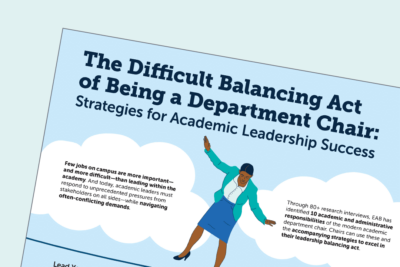How universities are planning return-to-work policies and guidelines
Results of EAB’s survey of senior HR officers
The COVID-19 pandemic quickly forced many students, faculty, and staff to operate remotely. University leaders rapidly learned how to coordinate online classwork, distribute technology, and support staff in a virtual environment. As the pandemic subsides, leaders must now decide how their campuses will operate in a post-pandemic world, balancing student and employee preferences with institutional priorities.
To better understand the return-to-work decisions being made, EAB deployed a survey across mid-May to analyze early movers and planned changes on the future of flexible work arrangements for university administrative employees (faculty arrangements were not included). 50 human resources leaders from higher education institutions across the United States, Canada, and the United Kingdom participated. Read on to see the main takeaways from the survey results.
1. Leaders anticipate a 17% increase in hybrid staff and a 2% increase in fully remote staff
Unsurprisingly, the future of campus operations includes increased hybrid work arrangements. Prior to the pandemic, respondents estimated that 6% of their staff worked in a hybrid arrangement; post-pandemic, that number is anticipated to increase to 23%. Fully remote employees will be a much smaller change, as leaders anticipate a modest increase in fully remote staff (i.e., 6% pre-pandemic to 8% post-pandemic).
2. The IT, finance, and procurement functions will see the largest increases in hybrid employees
Some departments are more conducive to hybrid working arrangements than others. For example, many Facilities employees would be unable to complete their job responsibilities in a remote setting. The nature of IT, Finance, and Procurement allow for greater flexibility than most other departments, which is reflected in HR leaders anticipating increased hybrid work within those functions.
Minimal increase
- Facilities
- Academic advising
Modest increase
- HR/legal
- Advancement
Significant increase
- IT
- Finance
- Procurement
3. Evaluation, equity, and manager training are the most pressing remote work challenges for HR leaders
A rapid shift to remote work during COVID-19 forced leaders into a survive—rather than a thrive—mentality when it came to tackling challenges caused by the new fully virtual environment. With the pandemic giving way to a new normal, overcoming barriers to successful long-term remote work has returned to the top of HR leaders’ list of priorities. The three most significant challenges shared include:
- Monitoring hybrid performance
- Promoting equitable policy for all employees
- Preparing managers to lead remote workers
For example, one chief HR officer shared concerns about the equity perceptions of allowing an IT worker four remote days per week and a Facilities worker one remote day per week. Policy decisions and individual inequities could lead to unhappy employees, resulting in disengagement, departures, or complaints.
Virtual meeting tools and tips: We’ve outlined virtual meeting tools and platforms, best practices, as well as alternatives to meetings to promote employee engagement.
4. Leaders disagree on whether to make remote work opportunities conditional
Administrative job postings increasingly include the term “remote eligible” as the pandemic subsides. Universities, however, are near a 50/50 split on whether a new employee can work remotely from the start of their role. 42% of respondents reported that new hires will be eligible to immediately begin in a remote environment. An additional 14% will allow fully remote privileges after in-person onboarding and orientation are complete. But the remaining 44% are maintaining pre-pandemic norms of requiring all new hires to start on-campus for a period of time before becoming remote-work eligible.
Will the institution hire a non-faculty employee eligible to start remotely from the date of hire?
Responses as of June 2021; n=50
- No, almost all new hires will start on campus: 44%
- Yes, for most positions: 42%
- Yes, but onboarding/orientation will be required in person: 14%
5. Most institutions will allow remote work 3+ days per week for hybrid employees
The consensus is clear on remote work limits. Two-thirds of universities surveyed will allow three or more days of a work week to be completed remotely (with a plurality imposing no limit on number of days worked in a remote environment). Only 6% of respondents mention employees will not be able to work from home in any capacity. After a year of remote operations, it’s clear that universities see the need to maintain a degree of flexibility for their employees’ work schedules.
Anticipated weekly remote work limits
Responses as of June 2021; n=50
Less than half of week
- No remote work: 6%
- Up to one day: 15%
- Up to two days: 15%
Majority of week
- Up to three days: 18%
- Up to four days: 2%
- No limit: 44%
More Resources

The difficult balancing act of being a department chair

4 Misconceptions About Employee Value Propositions that Every Campus Leader Needs to Confront
